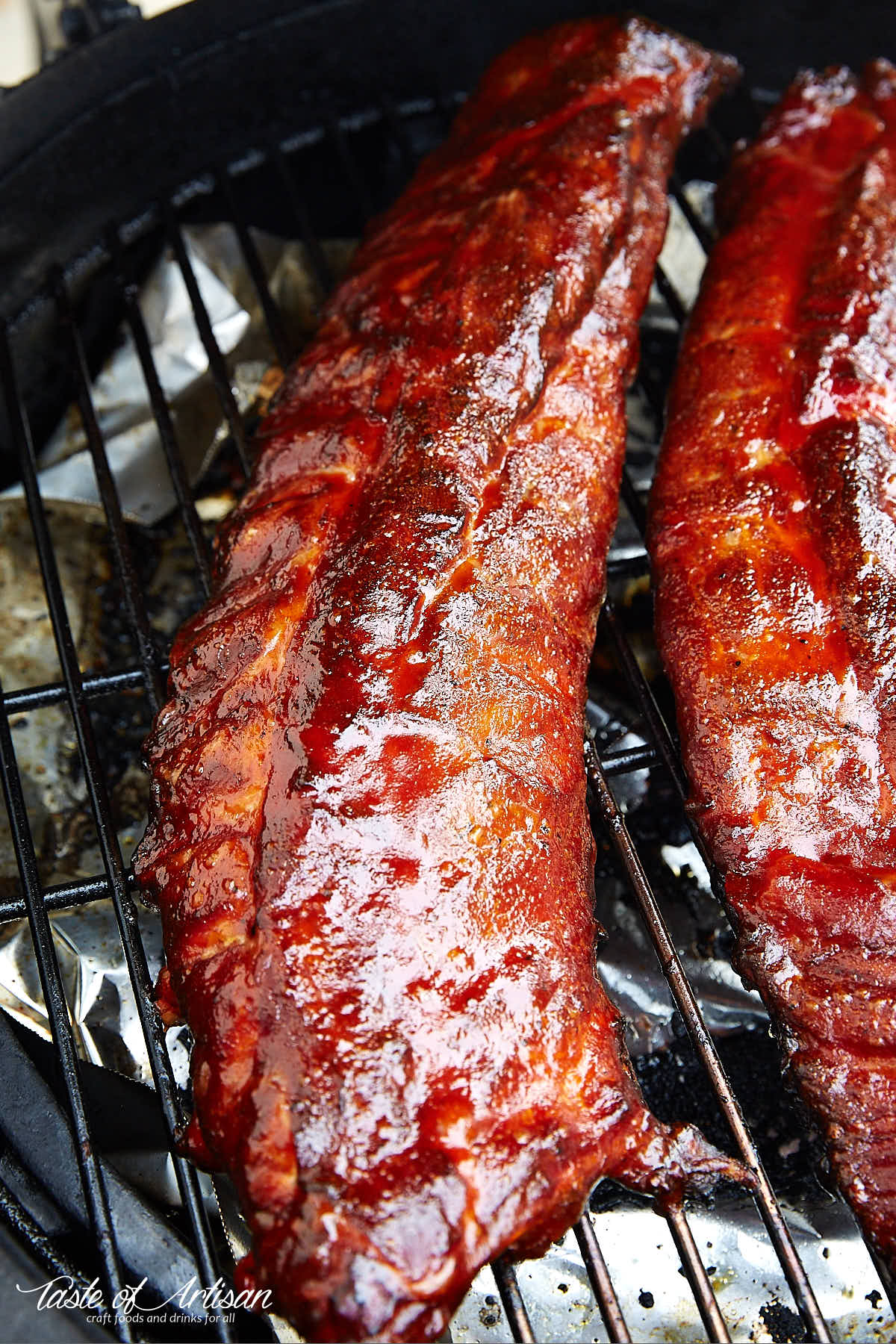
There are dozens of ways to cook baby back ribs and I've tried quite a few. The results varied from good to great. But there is one that really stands out for me - it's smoking. Smoking baby back ribs gives them that perfect combination of unique texture, bark, captivating color and the smoky flavor that just can't be replicated by any other cooking method. Smoking takes a bit of time, but really, who cares in the end.
I like my smoked baby back ribs leaner, firmer and not mushy, with a nice bark and a perfectly caramelized coat of barbecue sauce. The end result is what some call pig candy. I don't make them overly sweet though and use a very moderate amount of brown sugar in the rub.
The meat
Depending on where you buy your baby back ribs, they may have more or less meat and fat on them. Both are great choices, only difference is that the thicker, meatier racks will cook longer. I do like to trim off as much fat as possible. Greasy, fat dripping ribs are just not my thing. Some say that a layer of fat keeps the meat moist, but that has not been an issue for me. If anything, the fat prevents the smoke from penetrating the meat, which is undesirable.
Don't forget to remove the membrane from the back of the rack, it will improve the enjoyment of the meat later.
The rub
The kind of rub people use for smoked pork ribs seems to be a very personal thing. I am no exception. I prefer very mild tasting rubs that don't overpower the flavor of the meat and add just little bit of kick. The amount of the rub I use is very minimal. This makes the ribs taste like great barbecue meat, not spices. Some of the best barbecue joints in Texas I was fortunate to visit don't put any spices on their meats at all, only salt.
I've used the formula shown below for years and don't feel the need to modify it as everyone likes it a lot. Some people specifically asked me not to mess with it.
My rib rub formula:
- kosher salt - 4 tsp
- brown sugar - 2 Tbsp
- freshly ground black pepper - 1/2 tsp
- onion powder - 1 Tbsp
- garlic powder - 2 tsp (sometimes I use pressed fresh garlic and it's a great substitution)
- cayenne pepper - 1/2 tsp (double if you want a little more heat)
The amounts above are for 2 full pork rib slabs, with both sides of a slab seasoned. Cut in half if seasoning only the meat side.
In the past I used oil or mustard before applying the rub to make sure it sticks properly. Nowadays I successfully apply the rub directly to the meat. The surface of the meat is wet so the rub has no problem sticking to it. The way I apply the rub is to sprinkle it evenly across the surface of the slab and then pat down to make sure it sticks. Make sure your hands are dry otherwise you will end up with heavily seasoned hands. I apply the rub to both the meaty side and the back side of the slab.
Once the rub is applied the ribs are ready to go in the smoker. You can also prepare the meat in advance and refrigerate until you are ready. I often prepare and season the slabs the night before and find that it only benefits the meat as the seasonings have the time to get distributed more evenly. After an overnight refrigeration you will see that some liquid came out of the meat. Gently pat the slabs dry with a paper towel before putting them in the smoker.
Smoking
The smoker
Over years I've used a number of different smokers and grills to smoke baby back ribs. They all can be used successfully, but there are some differences to keep in mind. Electric and propane grills and smokers work but lack the depth of flavor that charcoal smokers produce. Propane smokers run drier so you need to account for that by placing a tray of water under the meat. Charcoal grills/smokers produce the best flavor and don't dry out the meat nearly as much, but require a little more tending and skill to operate them.
The temperature
Whatever grill or smoker you use, the most important thing is to keep the temperature stable within the desired range. Anywhere between 225F and 250F is perfect. If you go over 250F moisture loss accelerates dramatically and melted fat starts to leave the meat rapidly, resulting in dry final product. The ribs should be smoked over indirect heat, this is important.
I typically smoke baby back ribs at 240F-250F. The reason for the higher end of the range is that, in my subjective opinion, I get better color and softer texture of the meat. The cooking time shortens as well, which is great.
The Texas Crutch
Anyone who is familiar with smoking meats has probably heard of the Texas Crutch. It's a method of wrapping meat in foil for a period of time during the smoking process to speed up cooking and achieve more tender meat. It's often used in BBQ competitions. Some like it, some don't because the benefit is insignificant compared to some significant downsides. The biggest downside is that this method can seriously damage the bark, the smoke flavor and the seasonings. And if you are not perfect with your timing, you will end up with a slab of mush. I attempted this method with pork ribs several times and never liked the results. The flavor profile was sub-par and the meat lacked the texture I was looking for. It was too soft and more fatty. So I don't wrap.
The barbecue wood
Finally, a few words about the barbecue wood. There are several varieties perfectly suitable for smoking baby back ribs, from alder and maple to pecan and mesquite. Some are milder, some are very strong and may overpower the meat if smoking for too long. My personal all-time favorite is cherry wood. Cherry wood smoke is considered mild and you can't over smoke with it too easily. What I like the most about this wood is the beautiful rich dark red color it gives the food and the fruity, sweet smoky flavor. I usually have the smoke going for a good 3 hours and this gives me the best results.
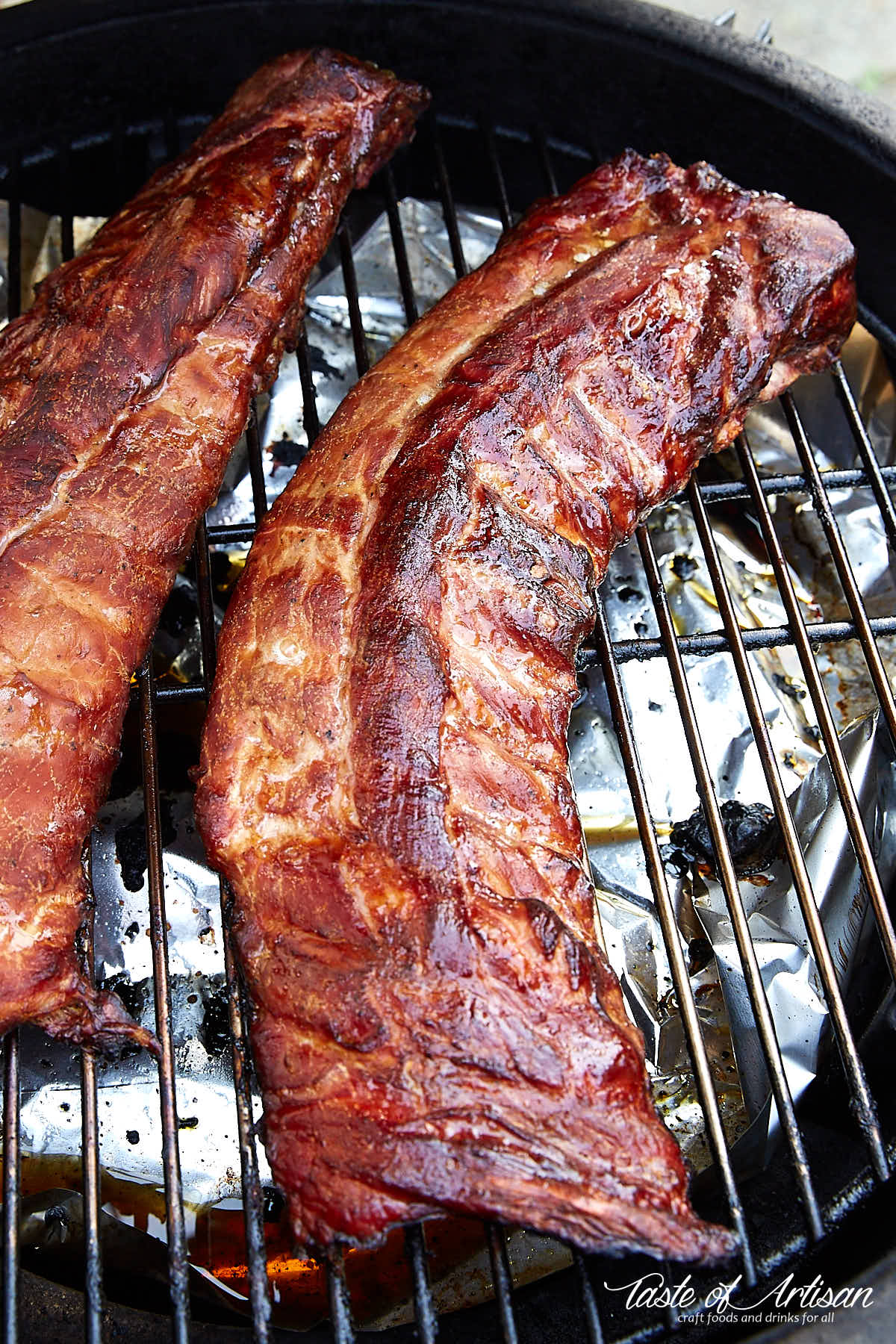
Checking for doneness
Thinner racks are typically done in about 3.5 hours, while thicker ones may take up to 5.5 hours. It's critical not to overcook them. It's better to check a little early than too late.
There are several ways to check ribs for doneness. The simplest one is the bend test. Pick up a slab with a pair of tongs and give it a gentle bounce. The meat is done if it cracks on the surface.
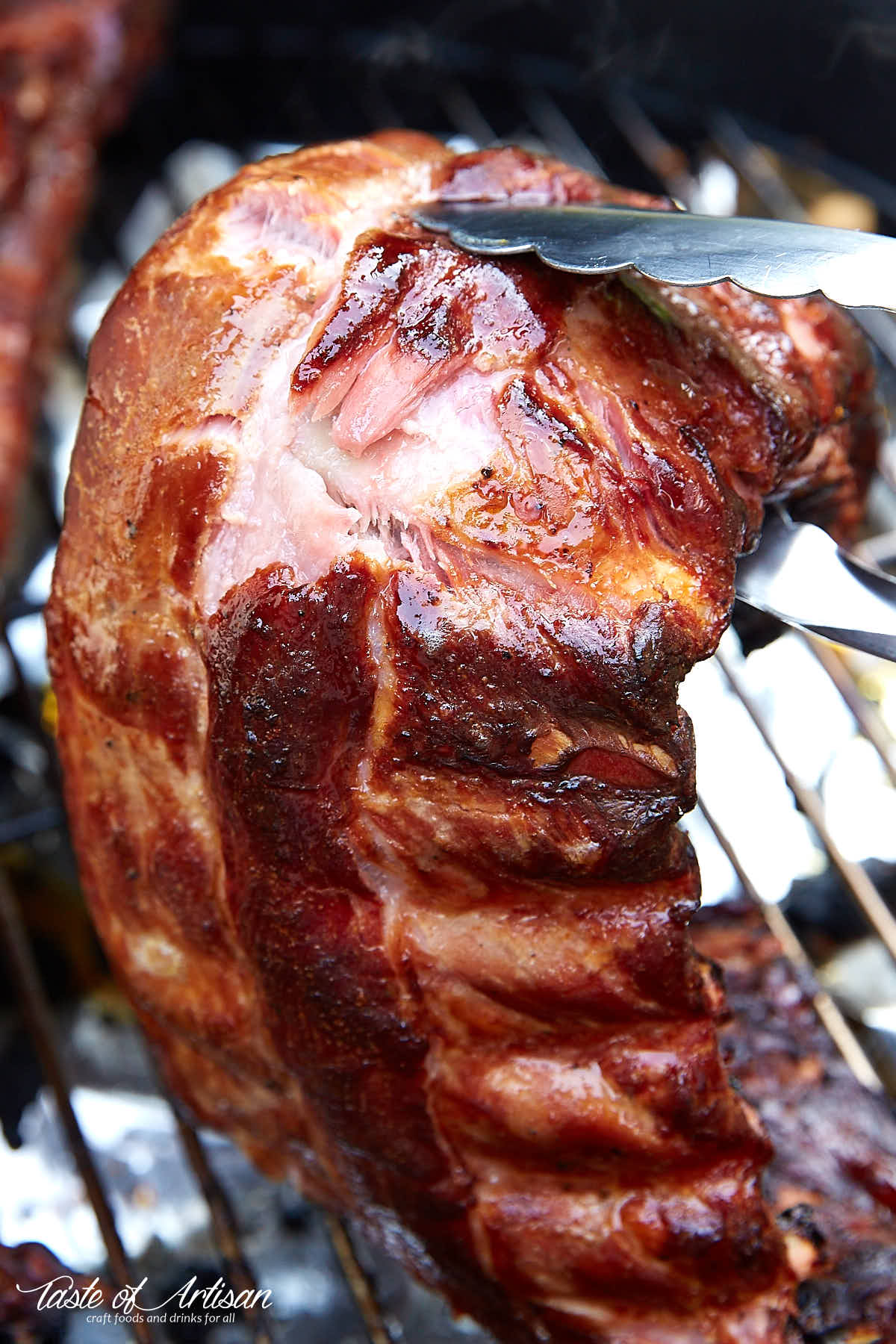
Just to be sure, check every slab. In my propane smoker the temperature at the top shelf would always be higher and the meat there would cook faster. What I would do to account for that is to switch the meat out between the shelves in the middle of the cooking process. Even if you cook all your slabs on the same level, hot and cold spots may impact doneness.
My preferred way to check for doneness is the bend test followed by checking the temperature with an instant read thermometer. Some gurus say that there is no sense in using a thermometer as the meat is too thin and the thickness varies from end to the middle. Fair enough. My experience is somewhat different though. I find that I get the best results if the meat reaches around 203F tested in the thicker part of the rack, right between the bones. This way I can also get predictable and consistent results every time I smoke ribs.
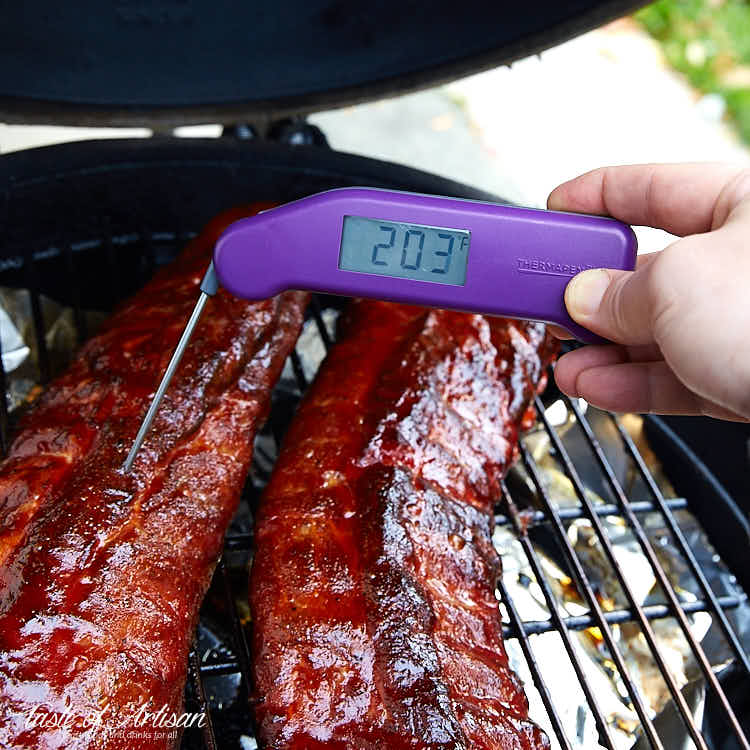
Applying barbecue sauce
This step is optional, but the ribs really benefit from it. Once the ribs are done, I apply a thick layer of my favorite barbecue sauce over the meat side of the rack. There is not much sense in putting sauce on the back side if the rack as there is no meat there. Any BBQ sauce will do. Just pick the one you like the most.
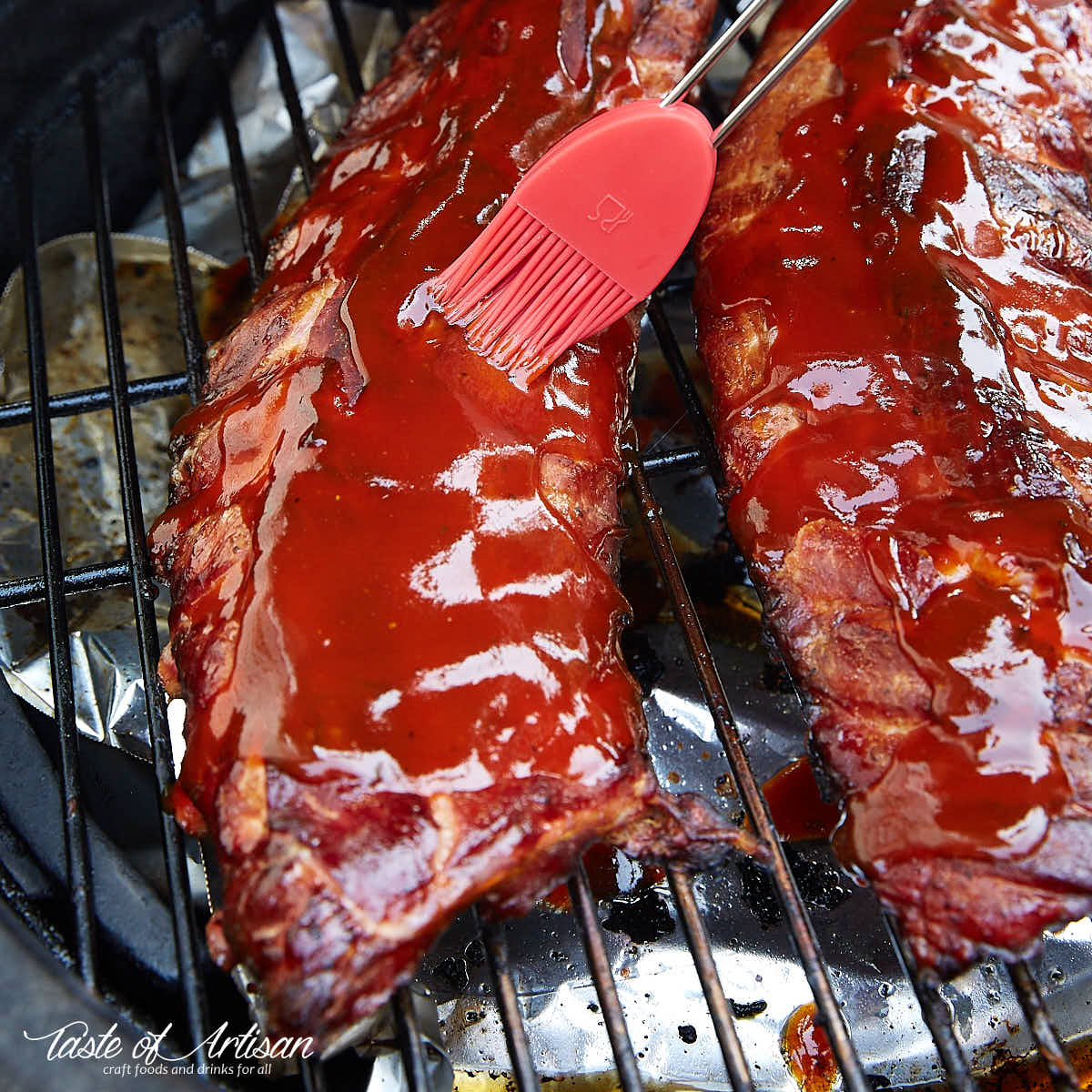
Once the sauce is applied I continue cooking for another 25-30 minutes at the same temperature (250F). If you smoke at 225F, I suggest increasing the temperature to 250F as the higher temperature will help thicken and caramelize the sauce properly.
These additional 25-30 minutes of cooking will not result in overcooked meat as the sauce (assumed to be at a room temperature) will quickly reduce the meat temperature. As the sauce is heating up and caramelizing on the surface, the meat temperature will be going back up. By the time the sauce is nicely thickened the internal temperature of the meat should be about around the desired target.


Tim says
Really useful guide for a smoking beginner like mr. Thanks
Victor @ Taste of Artisan says
Thank you for the feedback, Tim. Glad you found it helpful.
Kent says
Never got good results with smoked baby back ribs before without foiling but followed your method to the tee and got very impressive results. Will be making more for sure.
JC says
Thanks for the helpful tips. Made these smoked ribs yesterday, like you without foiling, and they turned out fabulous. I think I actually like the texture better when they are not foiled.
Nick says
Hey Victor... I'm making these tomorrow! One final question though. You stated in the post that you put the rub on then state the smoker and load in the ribs once the smoker is up to temp. Do you see any value in applying the rub and then refrigerating the ribs and, if so, for how long?
I will let you know how they turn out.
Best regards,
Nick
victor says
You can do that too, and I do it every now and again myself. There is definitely value in that the salt and spices penetrate the meat making it more flavorful inside, but you can't really fully appreciate it if you put the sauce on at the end. I do only when I want to prep ahead and not mess with the meat in the morning.
Nick says
Dang Victor... wish you lived nearby. I would enjoy your company and sharing bbq'ing with you.
I do have to say that I smoked my first pork butt on a weber kettle. I really didn't have a clue what I was doing but used the snake method. I also placed pecan wood chunks about five inches apart. I lucked out with the snake and it smoked the entire eight hours and the butt was fantastic. I have the ThermoWorks Smoke, as previously mentioned, and I could not believe once I placed the vents and the temperature stabilized , it held 225 degrees for the eight hours.
Well again, I sure do appreciate you replying to my posts and thank you for your assistance.
Kind regards,
Nick
victor says
Lol, so do I Nick. I owned three weber grills in the past, they are great but my biggest problem was smoking in the middle of winter in them. The thin metal they are made of is not conducive for smoking in cold weather. And the bottom burn out quickly, again, because of thin metal. Luckily, I picked them all from Craigslist in new or almost new condition for a fraction of the cost. BGE is another story, summer or winter, it just does its job.
Looks like you are quite happy with your ThermoWorks thermometer. I am not surprised one bit. I have three of them, a thermapen and two dual-probe thermocouple thermometers, like the one I have in a picture here. I've had all three for more years than I care to remember, 4-5 perhaps, or 6. All are going strong. Sometimes I wish one broke so I could justify buying one of the new models, a wireless one, ha-ha... Which is interesting as I went through 3 thermometers and many replacement probes that burnt out within a period of 3 years prior to buying them. Thermoworks is a Rolls-Royce of BBQ thermometers that's for sure.
Nick says
Hi Victor... the ribs look great. I have tried the 3-2-1 method and have not been satisfied with the results. They are good but not great!
You indicated in your write-up that for smaller racks smoke time is about 3.5 and for larger racks 5.5 and it appears you forego the wrapping. Would these times be approximate for both baby backs and St. Louis style ribs?
Another question is regarding the smoker temperature. I have a Smoke Pro pellet smoker with a gauge near the top of the unit. The gauge tracks perfectly with the temperature setting I have selected. I also have the ThermoWorks Smoke with two probes - one for the meat and one for the smoker temperature clipped on to the grill grate. I don't know if others have a gauge and also use external monitor, but mine NEVER read the same. The Smoke Pro gauge always reads lower than my Smoke unit with the probe mounted on the grate next to the meat. Please let me know which reading you believe would be most accurate.
Thanks again.
victor says
Hi Nick,
You are correct, I don't wrap, especially St. Louis style ribs which are fattier and, strictly in my humble opinion, they especially don't taste good when you wrap them. Wrapping is basically steaming if you think about it, and steamed fat doesn't taste that great... I noticed that when I smoke ribs unwrapped much more fat gets rendered out, making the meat leaner, which I like. And the bark is tastier too.
About the smoking time, I find that St. Louis ribs and baby backs need about the same time, smoked unwrapped. Side ribs need about an extra hour in my experience.
Temps are never the same at the grate level and at the dome or wherever the manufacturer decided to place the probe. On my BGE the thermometer placed at the dome always reads 25 degrees higher than the temp at the grate level. It has been consistently like that since day one, so now I don't even bother reading the grate temp, I know it's 25 degrees cooler.
Which one is more accurate? Both are accurate as long as the thermometers you are using are accurate. Temps will be different in different spots of any grill unless the heat flow and exchange is perfect, which is never the case. The question is which temperature is more important. That would be the grate level temperature as that's where the meat will be. I usually preheat to target temp range, say 225F - 250F, let the temp stabilize, then load the meat. If you pay attention to the temperature, you will notice that it will drop substantially as soon as you add cold meat. Don't worry and don't adjust it, it will come back up as the meat warms up.
Nick says
Hey Victor... wow! Thanks for your prompt reply. I have read that the temperature to monitor is at the grate where the meat is cooking and you've confirmed the same. If I set my Smoke Pro smoker to 250, the grate temperature should be about 225. I'll have to confirm this on my next smoke project. I'm in Michigan and staring out the window yearning for warmer days.
Thanks again for you reply.
Best regards,
Nick
victor says
No problem. Also, I wouldn't stress about the exact temps either. The only thing to really worry about is the final temp inside the meat. I've seen many home and pro/competition cooks smoke various meats at temps ranging from 225F to over 300F and get similarly great results.
You may think 225F is best but try 250F or higher and you may be surprised. I used to try to smoke at exactly 225F or 250F and that's not always easy with a charcoal smoker like the Webers I used to use or the BGE I mostly use now, or even with my propane Masterbuilt smoker. That made my smokes stressful and even un-enjoyable sometimes. So what I do now is I try to target a certain temp, and if it settles higher for whatever reason, that's not a biggie for me. I smoked chicken wings last weekend at 300F over indirect heat, way higher than the usual 225F-235F I target and the wings were amazing. I like the crispy skin a lot. What a breath of fresh air after the typically rubbery skin you get at 225F. Guess what, I am not smoking my wings at 225F anymore as I want them crispy now.
Faylinn says
Your post is so good that I can practically taste the baby back ribs in the pictures. They remind me of when I lived in Oklahoma and my neighbor would call me up and have me come have dinner with his wife and him so that he could have an excuse to fire up the smoker. He always used Head Country barbecue sauce. Now, I don't remember too much about how he was able to create the meat that he did, but I do know that he was very specific about the type of wood chips that he would use. What type of wood chips do you use when you smoke meat?
victor says
Thanks for the feedback, Faylinn. I've tried many different types of wood, but for me there is nothing better than cherry wood. No other wood gives me the same color and sweet flavor of smoke. When I can find it, I also use sweet cherry wood. It's even better in my humble opinion.